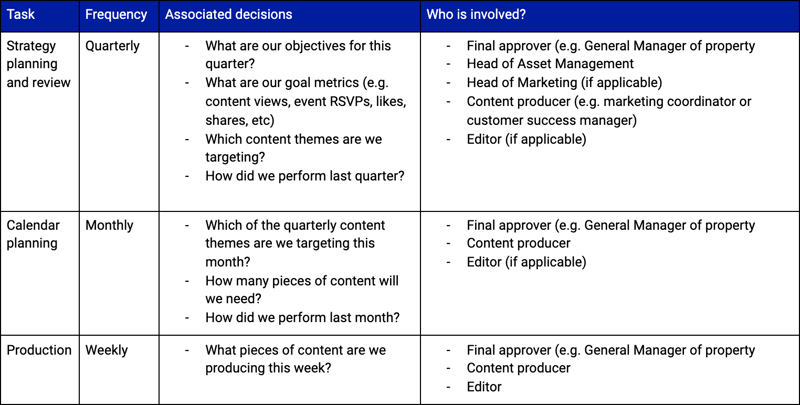This post will assume you operate a small building management team, without a sizable marketing or content production appendage. Fortunately, this minimum viable output approach will help you to easily scale if you have a large, well-equipped team (or if your team grows at some point in future).
For the purposes of this set-up guide, let's call your hypothetical communications offshoot the "Comms A-Team".
1. Select your final approver
In order to produce content quickly and at scale, it's important that your Comms A-Team is made up only of essential team members. Many content teams are top-heavy with final approvers, and this structure inevitably results in bottlenecks and inefficiencies. Your Comms A-Team need not necessarily include high-level executives who are not involved with the day-to-day operations of your asset. You will need their buy-in, of course, when it comes to overarching planning, but they will need to trust that your Comms A-Team can get the work done on the ground.
Select one final approver (or two, at most). This team member will be responsible for signing off on the communications strategy, briefing content producers, and giving final approval to big comms campaigns. They should not be involved in content production duties unless absolutely necessary.
2. Appoint your content producer
It may be fantastical to suggest your building management team should have its own in-house dedicated content producer. If this is not feasible, look next to your marketing or customer success representatives. Failing that, you might enlist an affordable freelancer or agency ringer.
The amount of producers you need will depend on the volume of communications you intend to produce. In our experience supporting building management teams, the basic rule of thumb is this: One makeshift producer can reasonably produce one to two pieces of original content per week, of about 500 words each, assuming the plan from which they work has been adequately set. Therefore, for most building management teams, the work of one makeshift producer (say a marketing coordinator or customer success manager) will be more than enough to bring your communications strategy to life. As we'll discuss later on in this guide, the goal is not high output but consistency and quality.
3. Enlist a graphic designer
It's pretty common for a marketing coordinator or manager to have decent graphic design skills. You don't need a Photoshop expert to create good communications — only someone with an eye for imagery, who can effectively use basic (and free) image alteration tools like Canva. Every piece of well-written content deserves a good image to increase its appeal to window shoppers. A subscription to a stock image service (like Getty) is ideal, but for those without the budget, free stock image sites like Unsplash have fantastic libraries.
4. Set, if possible, an editor
Ideally, your chosen content producer should work as part of a duo with an editor. The editor is responsible for reading, cutting, refining, and proofreading the work of the producer. Generally speaking, content producers or marketing professionals can serve as decent editors. The most important tasks are correcting errors of spelling and grammar, and ensuring the content fulfils the objectives specified in the communications strategy.
If, due to resources, you cannot justify an editor and producer, your final approver can perform the role of editor. After all, part of the responsibilities of the final approver is to find errors and strategic inconsistencies before giving assent to publication. In any case, the way in which the editing role is performed is less important than ensuring that it is performed, with each piece of content. Always have another pair of objective eyes looking over work.
5. Configure your team production schedule
As said above, consistency is key when it comes to production output. To ensure content progresses efficiently from draft to final proof to publication, your Comms A-Team needs to know when work needs to be completed, who needs to edit it, approve it, publish it, and analyse it.
We recommend the following configuration. In our upcoming eBook, the CRE landlord's guide to creating a complete tenant communication strategy, we'll examine in greater depth how to create a weekly content calendar populated with deadlines and responsibilities.



